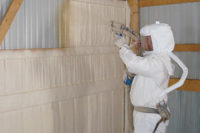As the winter days get longer and spring brings more temperate days and blossoms, the nights are gradually more moderate. But with rising energy costs and a heightened global focus on energy efficiency, it’s important to get the most out of your heater and not let any hot air go to waste. One of the most effective ways to do this is through the use of insulation, and one of the most cost-effective ways to insulate the space you’re building or designing is with a polyisocyanurate installation.
Polyisocyanurate (shorthand “polyiso”) is one of the most widely used building materials in the world. It accounts for more than 75 percent of the insulation used in commercial building construction in North America. It’s most commonly used as continuous insulation or as a protective cover board. A closed-cell, rigid-foam board that is bonded to facers on both sides of the board, polyiso is predominantly composed of organic materials, including polyol, a blowing agent and polymeric methylene diphenyl diisocyanate. This formulation, coupled with its use with different facers, imparts a number of benefits on the user: compatible with a variety of roofing systems, third-party certified long-term thermal performance, low global warming potential blowing agents and industry-wide Environmental Product Declaration.
Special Features
While polyiso is essentially equal to gypsum, a popular alternative, in features like moisture resistance, fire resistance and other uplift properties, the advantages are that it is lighter, easier to ship and simpler to maneuver. In fact, polyiso cover boards can protect the underlying insulation from a building’s traffic and allow the structure to be used for renewable energy systems, such as a solar power system. It also provides a high R-value, a measure of how well a product insulates.
High R-values mean that the material insulates more efficiently and is better at insulation—an inherent benefit of polyiso cover boards.
With contemporary energy codes instituting minimum insulation requirements, polyiso is an excellent choice to meet and even exceed those standards.
Installing polyiso insulation on any roof will contribute to the building’s overall thermal efficiency while also making it more fire-resistant and helping cut energy costs. The global warming potential of the blowing agents that are used when manufacturing polyiso insulation is important to consider when evaluating its environmental impact. GWP is a comparison of gases to determine their global warming impact, specifically how much energy the emissions of one ton of a certain gas will absorb relative to one ton of carbon dioxide in a given amount of time. North American manufacturers use pentane, a hydrocarbon with zero ozone depletion potential and low-GWP, or pentane blends in the production of polyiso insulation products.
With pentane’s GWP value of less than 10, polyiso insulation products produced and sold in North America are compliant with climate regulations that restrict the manufacturing or installation of products that have higher GWPs. This means that contractors can confidently recommend polyiso insulation products knowing that they are compliant with any regulations. By also creating protective air barriers in top floors that seal off a building from the outside elements and decrease the need for large heating and air conditioning units, polyiso will save energy in more ways than one.
Other Properties
The structure of polyiso leads to its exceptional fire-resistant properties. Isocyanurate chemical bonds leads to a high-temperature invulnerability of nearly 390 degrees Fahrenheit, more than double that of most insulation foams. This makes polyiso less susceptible to surface burning and can help prevent flames from spreading. With the stringent criteria of codes related to fire performance in commercial buildings, contractors will have much more flexibility when insulating with polyiso.
Polyiso insulation has always been a leading insulation choice for commercial roofs, and new technological advancements in the formula makeup continue to make it more economical and environmentally friendly. Elevate ISOGARD polyiso insulation offers a solution for commercial challenges, as it’s engineered to protect against everything from ponded water on a low-slope roof to cold weather. The thermal performance of ISOGARD polyiso insulation is up to 40 percent better than major competitors when tested by an independent third party in cold temperature (40 degrees Fahrenheit) applications, according to ASTM C1289 standards.
The increased R-value per inch means better thermal performance from the same systems using the same amount of insulation compared to leading competitive products on the market today.1
When building or designing the building envelope this winter, consider a polyiso insulation installation.
References
1 Actual performance attributes may vary based on many factors, including specific building features like skylights, wall insulation and HVAC performance.







